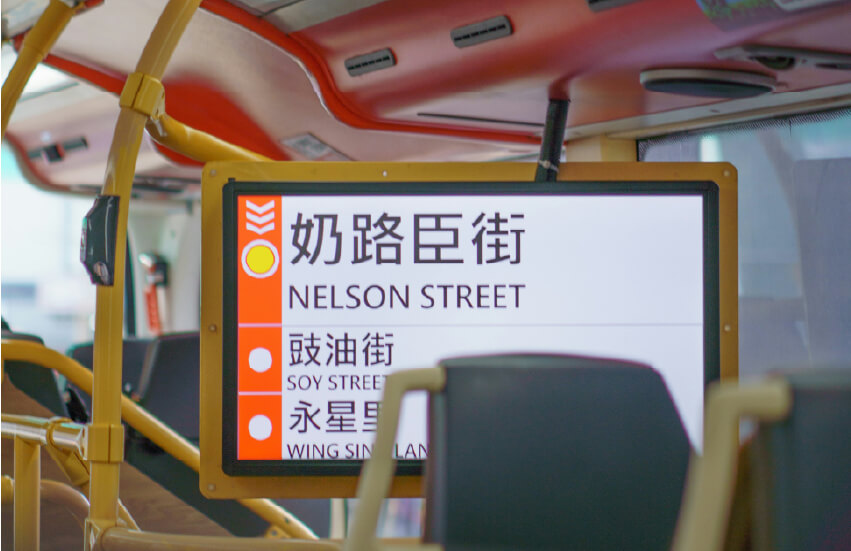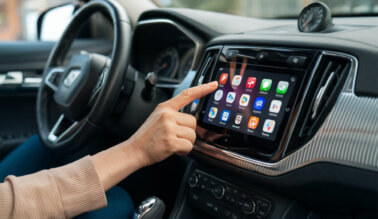How Cellular Networks Keep Digital Signage and DOOH Online
by Webbing Team | October 22, 2025
Screens follow us everywhere – inside buildings and outdoors, on city streets and highways, on buses and in taxi cabs – showing maps, directions, ads, alerts, and menus. Last year, Berg Insight reported that the number of connected digital signage displays worldwide was 91.5 million in 2023 and forecast it to reach 149.4 million units by 2028.
One of the main drivers behind this growth is advertising. While digital signage is a clear concept of using digital displays to present multimedia content in public environments, its subset called Digital out-of-home (DOOH) may need some explanation. Simply put, DOOH advertising delivers dynamic ads on connected screens in public places. Advertising is typically managed by a cloud CMS and ad server. The screen owner uploads and schedules ads from a central system, and advertisers can buy space directly or automatically through ad platforms.
Each screen downloads ads over a cellular or fixed connection (where it is available and practical), then plays them based on rules like time of day, location, weather, traffic, or nearby events. The screen reports back what ran and when (so-called “proof-of-play”). Audience exposure is estimated with analytics like venue footfall sensors or mobile location panels. The result is TV-like storytelling with digital targeting and measurement, which is optimized in near real time and scales across thousands of venues.
Early DOOH displays operated entirely offline. Screens used a local media player that looped preloaded content from memory cards or USB sticks, with simple time-based schedules set on the device clock. Updating campaigns meant physically visiting the site to swap media. Proof-of-play and health checks were manual, or data was not collected at all, so outages could go unnoticed, and campaigns were hard to verify. Network connectivity has transformed the landscape and has become the norm. With a network link, advertising operators can send new ads remotely, see if each screen is healthy and fix issues fast, prove exactly what ran and when for billing, and change content automatically.
Cellular connectivity is crucial for digital signage and for DOOH in particular, because many screens are located in places where there’s power but no wired internet. Mobile networks keep operations and revenue flowing by reliably delivering content updates and schedules, while supporting secure remote monitoring and fixes without additional truck rolls.
There are many different types of digital signage screens, from small bus-stop e-paper signs to large billboards. Let’s take a look at the screen categories that depend on cellular connectivity the most:

Roadside Billboards
Roadside digital billboards oftentimes sit on poles or street furniture with only power available, so there is no internet to plug into. Additionally, they are spread over long distances where trenching fiber or negotiating venue Wi-Fi is impractical or too time-consuming.
Cellular networks give each billboard an immediate internet connection almost anywhere. With that link, the player on the billboard (a small computer) regularly downloads new ads and schedules from the company’s content management system, reports what it showed and when, sends health data so ops can catch problems early, and allows secure remote support.
Because the structures are exposed, roadside billboards have specific connectivity requirements, including a tough industrial LTE or 5G router, dual SIM or multi-carrier failover, a high-gain directional antenna aimed at a cell tower or a well-placed omnidirectional one.
Dual SIM failover uses two physical SIMs, typically tied to two specific carriers. The router can switch between the SIMs in case one of the networks is down or there is no signal for some reason. It may provide good hardware diversity, but implies managing two physical cards, and what is equally important, two contracts. Changing carriers requires physical SIM replacement.
Multi-carrier failover means that one eSIM holds multiple carrier profiles, and the device can swap between them based on certain conditions, such as signal strength or latency.
With Webbing’s global connectivity solution, WebbingCNCT, both SIM slots can take advantage of automatic failover between networks, with no need for separate contracts. Additionally, WebbingCTRL eUICC SIM cards take this a step further by removing the need for physical SIM replacements altogether. Using Remote SIM Provisioning (RSP), carrier profiles can be securely added or updated over the air, ensuring continuous connectivity, simplified management, and true flexibility at a global scale. Webbing’s eSIM can become any provider’s SIM in a minute, allowing to easily change carriers at any time with zero integration, and to fall back from a failing profile to a different profile without any need to communicate with a remote server. Coupled with Webbing’s global connectivity, backed by an ecosystem of over 600 mobile operators in more than 190 countries with the capability to use multiple mobile carriers in every region, it ensures resilient, uninterrupted connectivity.
Taxi-Tops & In-Vehicle Screens
Since taxis and rideshare vehicles are in motion all day and rarely have access to fixed networks, taxi-top and in-vehicle screens rely on cellular connectivity as their primary backhaul. This model is proven at scale: in 2024, Uber signed a partnership with T-Mobile to expand Uber’s JourneyTV offering to over 50,000 vehicles across the US, and later reported that the partner network operates about 75,000 in-ride screens nationwide.
Along with keeping these screens online, cellular connectivity enables geo-targeted, context-aware advertising. For example, Firefly has installed digital signs atop hundreds of taxis and rent-on-demand vehicles in Los Angeles and San Francisco. The rooftop signs receive “situationally aware” ads via cellular transmission, with targeting based on location, time, intended demographic, weather or other contextual data. The screens deliver ads designed for drivers’ specific paths, with a granularity that can go down to a city block.
Each vehicle carries a media player and a GPS module for location-based targeting and compliance. The player periodically downloads new creatives and playlists over a cellular connection, then plays from local storage. Large file downloads, like new video spots or app updates, are usually queued for when the car is parked, often overnight, so they don’t have to deal with weak or fluctuating signal while driving.

Transit Passenger Info Displays
While seemingly similar to the previous use case, these devices have one major connectivity requirement that makes them stand out: they need continuous data connectivity for real-time updates. Transit passenger information displays show real-time arrivals, service alerts, headways, and line maps either on vehicles such as buses, trams, and trains or at stops and stations. They come in many form factors, including regular screens, e-paper or LED signs. They can also be solar-powered, and in this case, thanks to cellular connectivity, they can be installed virtually anywhere in 30 minutes.
On vehicles, the display usually connects to the vehicle’s LTE/5G router with GPS to periodically pull real-time feeds for predicted arrivals and disruptions, and then render them alongside the current stop and next-stop information. At bus stops, displays use cellular as the primary backhaul to fetch the same feeds plus agency messages. Both types send health data and proof-of-message updates back to the control center; large software and firmware updates are typically scheduled for off-peak hours.
A good example of both use cases is Seattle-based King County Metro. The largest public transportation agency in Washington state has installed LTE routers in 1,700 buses to keep on-board devices and applications connected, and to enable the IT team to monitor data security and troubleshoot the network from anywhere. This setup also enables centralized configuration and management with point-and-click tools for tasks such as firmware and security updates, for instance, scheduling updates to push out across the fleet simultaneously at 3 a.m.
In parallel, strategic bus stops were upgraded with cellular routers to provide connectivity for digital signage that displays current bus arrival times, and for fare collection devices that sync payment information
For use cases like this, multi-carrier access across the service area is essential, and for vehicles, seamless cell handoffs at speed are also critical. Connectivity solutions need to provide failover options and good coverage, but since every mobile network may have its weak spots, the requirements here can be more than just “change profile if the network is down”. That’s why, along with access to several mobile carriers in every location, Webbing’s connectivity solutions provide additional capabilities to ensure that a device is always connected to the best available signal, and allow to manage eSIMs and define the rules for automatic profile swap.

Connectivity Requirements for Digital Signage
Cellular connectivity plays a critical role in digital signage. As the use cases show, although they are quite different, certain requirements may be similar. For instance, since content is pre-downloaded and stored locally on the player, playback doesn’t depend on constant high speed. However, the connection needs to be reliable enough to fetch content updates and handle small control messages. There are also other connectivity requirements common for all digital signage displays:
Coverage
A screen that can’t reach the network can’t get new ads, send proof-of-play, or report problems. Digital signage sites are spread out, and many displays are mobile, so signal can vary. Cellular connectivity with multi-network access and fallback options is often the only feasible solution. Without sufficient coverage, service interruptions can occur.
Security
Digital signage screens are unattended computers in public places, and they can be targeted by bad actors. Attackers may try to hack the systems and push tampered content – from physically accessing on-site controllers to gaining unauthorized access to on-premise digital signage platforms via a phishing attack.
Cellular connectivity has a number of advantages when it comes to security. Each device has a SIM or eUICC profile bound to a carrier account and often to a specific device, which provides a stronger hardware identity. Traffic can be run over a tunneled, private network path (private APN) rather than the public Internet, giving a more isolated network environment. Besides, with certain endpoints like bus shelters or roadside billboards, using cellular means avoiding dependencies on LANs which may be poorly secured. However, physical risks such as router or antenna theft still exist.
Operations and Data Usage Control
Advertisers and cities expect accuracy and auditability. Cellular connectivity provides a controllable link to every device, allowing to queue big files and push content or firmware overnight, without depending on a venue’s Wi-Fi. Scheduling and staging updates prevent outages during business hours. Accurate time and dependable reporting prove what ran and when, and a continuous cellular link is important for nonstop telemetry, so clocks stay correct, and logs arrive on time. Also, cellular connectivity provides many tools to manage data usage that keep costs predictable and meet legal or contractual obligations. For example, per-SIM data caps and policy rules allow to control data consumption, and eSIM with local carrier profiles helps comply with roaming or data localization rules.

Webbing’s Connectivity Solution for Digital Signage Displays
Webbing provides reliable, low-latency internet connectivity for digital signage screens wherever they are located. Webbing’s connectivity solutions guarantee global coverage, and through our ecosystem of over 600 mobile operators worldwide, devices can roam seamlessly across multiple carriers’ networks in every region. It solves the problem of weak spots that any mobile network may have and ensures full coverage and continuous connectivity for all devices, even at remote locations.
Webbing is a full MVNO that has a fully redundant distributed core network infrastructure with data centers on every continent. It is well suited to support mission-critical, high-data consumption type of use cases and provides connectivity stability and low latency. It also allows for all types of localization, making it easy to comply with local regulation requirements even in heavily regulated markets.
Our eSIM solution ensures failover connectivity with the capability of using multiple mobile carrier profiles, easily changing carriers at any time, and an option to fall back from a failing profile to a different profile without any need to communicate with a remote server. Webbing also offers a portal to manage eSIMs throughout their lifecycle. It allows for defining business rules that govern the automatic profile swap process and provides visibility to profile usage and network events, to guarantee transparent connectivity. With Webbing’s solution enterprises can manage connected devices in bulks, easily scale global IoT deployments, monitor and control the data usage of each device.
Our solutions help enterprises overcome their connectivity problems and reduce time to market for digital signage deployments, providing the benefits of roaming with multiple carrier options and seamless transition between carriers with a single SIM.
Reach out today to learn more about Webbing’s connectivity solutions for digital signage applications.




